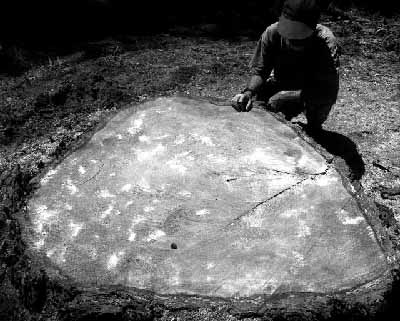
© copyright 2000 Michael P. Hamilton, Ph.D.
What Good is Old Growth?
April 27, 1997:
The pile of cut and stacked logs towered thirty feet over our heads as my colleagues and I diligently counted the minuscule rings that gave us a small measure of the value of the trees. One hundred and fifty....Two hundred...Two hundred and fifty rings, the outermost were so small I had to use my hand lens to identify the annual divisions, and I'm sure I missed a few. There was a half dozen piles of stacked logs numbering more than a hundred trees recently logged on the slopes of Black Mountain surrounding the group camp. A few of the trees were dead snags, but the majority were living trees of large stature and diameter. The age of dozens of sugar pines, incense cedars and Jeffrey pines were beyond 200 year old, more than qualifying this stand as an Old Growth Forest.
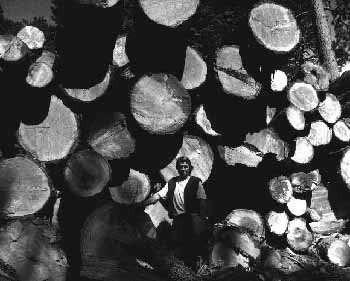
one of several log piles at the Black Mountain Group Campground
The cutting of old growth forests has gotten much national and international press in the last decade, particularly in the pacific northwest as commercial harvesting is now cutting the last 5% of North America's oldest forests, and rare species such as the Spotted Owl and the Marbled Murelet face extinction without some drastic change in logging practices. In our local mountains since the late 1980's, the U.S. Forest Service has been systematically cutting old growth stands to rectify a problem they describe as "decline in health and vigor," and in the cause of "tree hazard removal." Most of these cuts have been made with little or no public discussion, and without adequate environmental and biological studies to determine the significance of logging.
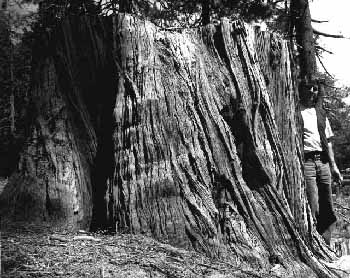
cut stump of 7 foot diameter Incense Cedar. This 350 year old tree is being carved into a "Right to Life" tree for the next Olympics in Utah
Technically, an old growth forest is more than a stand containing old trees...it is a living ecosystem that supports numerous species of plants, wildlife, and insects that are dependent upon ecological conditions that cannot be found outside of mature forests. Without old growth forests, old growth dependent species go extinct. When you walk through an old growth forest, you are likely to notice mature trees of all ages, relatively few seedlings and saplings, large standing dead trees called snags, downed logs on the forest floor, large fallen logs in streams, trees aged over 200 years, and little or no evidence of logging. Until recently, these conditions existed on Black Mountain. However, forestry professionals whose living is based on managing homogenous stands of fast growing trees of commercial value, seem to feel that old growth is stagnant, non-productive and of little value unless they cut out the dead and decadent trees and replace them with seedlings.
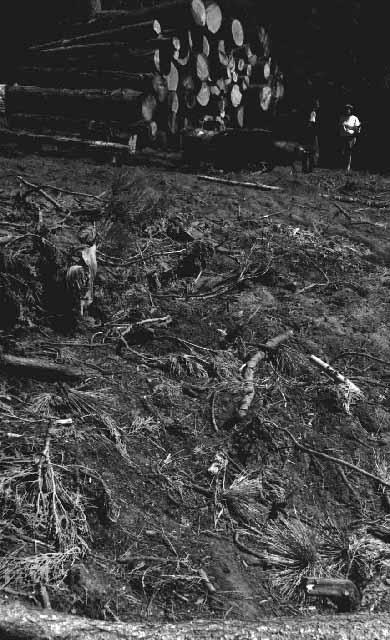
extensive soil damage from bulldozers, leading to erosion and contamination of Black Mountain Creek
What is unique about old growth? As a tree age, it can develop superficial diseases that cause branches to break and decay, leaving dens and cavities for birds and mammals to find cover and build the nests. The mycorhizal fungi that cover the roots of older trees provide food for flying squirrels and rodents. Tree tops flatten out due to frost and lightning damage, creating perching roosts for large raptorial birds like eagles, and for owls. A tall, old forest has a shaded and generally open understory with thick layers of ground debris that traps moisture and supports delicate herbs, fungi, and amphibians.
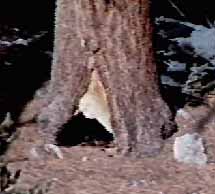
most old growth show fires scars at the base of the trunk
Finally, old growth forests can resist wildfire because old trees have thick heavy bark that insulates the cambium, and lower branches have long ago broken off thus reducing the fuel ladder that allows a fire to move from the ground up into the crowns. Fire has always been a part of the old growth forests, but the impact is more beneficial because wild fires tend to be slow burning ground fires rather than devastating canopy fires. Large stands of even aged young trees, like most of trees in and surrounding Idyllwild, are prone to large outbreaks of bark beetles and parasites, have lower diversity of associated wildlife species, and tend to be more fire prone because they dry out faster during drought and have branches close to the ground.
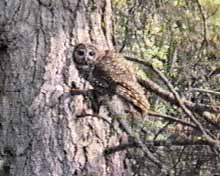
California Spotted Owl on Black Mountain
More than one hundred wildlife species in our mountains depend upon old growth forests and include birds, mammals, reptiles, amphibians and insects. Many of these species known from the forests on top of Black Mountain are so rare that they are categorized as candidates for federal and state protection. Unfortunately, the U.S. Forest Service is making their logging decisions without conducting studies to see how old growth dependent wildlife
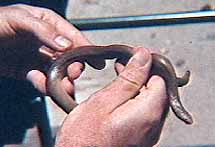
This Southern Rubber Boa captured on Black Mountain is a California state threatened species
would be affected by selective cutting and associated soil disturbance. For many years ornithologists have been visiting the Black Mountain Group Camp to observe breeding pairs of Spotted Owls and Flammulated Owls, rare birds who build their nests in cavities and crevices of tall older trees and snags. Throughout the San Jacinto Mountains there are fewer than 15 active pair of Spotted Owls, and they have been declining every year. Other declining bird species include Brown Creeper, Black Swift, Purple Finch, Mountain
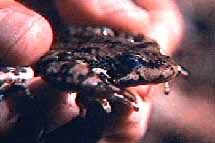
Mountain Yellow-legged Frog found in Black Mountain Creek
Chickadee, Downy Woodpecker, Common Flicker, Northern Goshawk, Oregon Junco, Pine Siskin, Violet-green Swallow, Western Wood Peewee, and Red-bellied Sapsucker. The logging that is occurring at this time is disturbing the breeding activities of not only most of these birds, but of Northern Flying Squirrels, Spotted Bats, Southern Rubber Boas, Ensatina Salamanders, and the Mountain Yellow-legged Frogs.
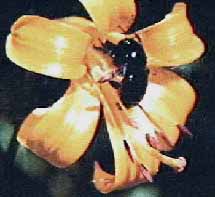
The rare Lemon Lily depends upon undisturbed streamside habitat along Black Mountain Creek
Current Forest Service policy that
condones logging of old growth in the San Jacinto Mountains is
in desperate need of revision. The old notion of health and vigor
as a rationale for cutting ancient trees is out of step with
national forest ethic that call for them "to tell the truth,
obey the law, work collaboratively, and use appropriate scientific
information in caring for the land and serving people."
Once an old growth forest is gone, there is no guarantee that
it can return, as history has shown throughout the world.
Notes on decline in mixed conifer forest breeding birds of California
